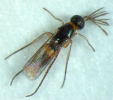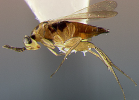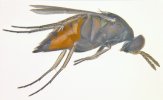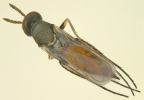 |
Scientific nameElasmus spp.
Taxonomic positionHymenoptera: Chalcidoidea: Eulophidae: Eulophinae: Elasmini
DiagnosisBody elongate, wedge-shaped, fly-like and hairy in general appearance; brown to black in colour, rarely yellowish, usually with slight metallic luster. Antenna with funicle not more than four-segmented. Scutellum with a triangular apical projection. Propodeum medially elongate. Fore wings elongate and narrow, densely covered with setae, with a very long marginal vein. Hind coxa large, greatly swollen and disc-like, laterally flattened and tightly apposed to the body; hind tibiae with diamond-shaped or undulating setal patterns (sometimes setae arranged in parallel rows). Tarsi four-segmented; meso- and metatarsi visibly elongate and slender, slightly tapering towards apex.
The genus Elasmus is the only genus in the family Elasmidae, treated as a subfamily of Eulophidae by many authors. Based on recent molecular evidence from DNA analyses of Eulophidae and Elasmidae, Elasmidae has been reduced to a tribe of the subfamily Eulophinae (Gauthier et al., 2000). Elasmids are treated as a separate family just for ease of reference and also due to their rather distinctive appearance. Images
 Elasmus sp. - Male in dorsal view Elasmus polistis Burks Elasmus sp. - Male in dorsal view Elasmus polistis Burks
 Female in lateral (left) and dorsal (right) view Female in lateral (left) and dorsal (right) view Adult - lateral view Adult - lateral view Mesosoma (arrow mark indicates triangular scutellar projection) Mesosoma (arrow mark indicates triangular scutellar projection)
DistributionCosmopolitan. The sole genus Elasmus under the tribe Elasmini has about 260 species
distributed world wide.
Hosts / BiologyElasmids are either primary external parasitoids of the larvae of Lepidoptera or hyperparasitoids on them through various Hymenoptera, in particular the Ichneumonidae and Braconidae. Some species develop regularly both as primary and hyperparasitoids. They are usually gregarious. Hosts are usually attacked within a web, larval case or cocoon. Elasmus polistis Burks has been recorded as an endoparasitoid of the wasp, Polistes sp.
Elasmids are rarely abundant enough to be of any importance in the control of their hosts. The species are most diverse in the Old World tropics. In India, Elasmus nephantidis on coconut blackheaded caterpillar and Elasmus zehntneri on sugarcane top borer are commonly collected. References
|
